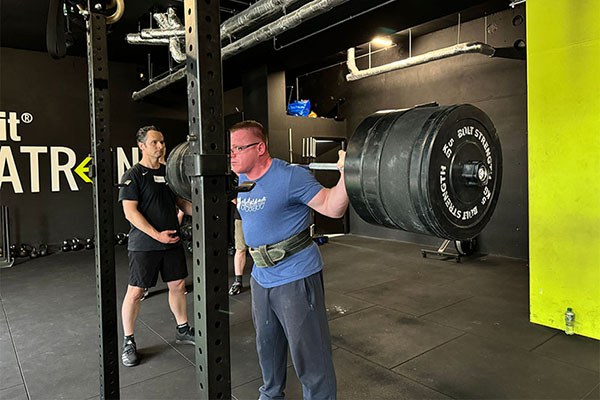September 16, 2024
Harvest Moon Edition
On Starting Strength
-
Controlling the Controllables: Stress, Recovery, Adaptation –
Rip covers the variables you can control in your training, such as consistency, compliance, and recovery, and discusses factors beyond your control, like genetics. He also explores common reasons why your progress might be stalled and how to address them. -
Safety in a Barbell Training Gym by Mark Rippetoe –
A long time ago, barbells were thought to be dangerous. This was a common belief among doctors, your grandparents, gym teachers, real estate salesmen, guys who maintained swimming pools, the manager… -
Mastering Bar Control in the Press –
Rip breaks down the mechanics behind the importance of keeping the bar close during the press. -
The Map of Athletic Performance by Rob Miller –
Training is a confusing subject. Conflicting points of view have a way of making productive dialogues a rare event. For me as a dedicated rock climber, it’s been… -
How to Set Up a Training Log –
Grant Broggi, Starting Strength Coach and Owner of The Strength Co, explains the purpose and set up for a proper training log. - Weekend Archives:
The Ideal Image of a Woman by Inna Koppel –
The barbell as a cultural icon representing strength has been unjustly assigned only to men. Although the benefits of barbell training to women are the same… - Weekend Archives:
Why Being Sore Doesn’t Mean You’re Getting Stronger by Mark Rippetoe –
Training with weights produces muscle soreness. Many people don’t like to be sore, and that’s why they won’t train for strength. Running also makes you sore…
In the Trenches

Terry walks out the squat as Kevin stands in the right-side spotter position during the recent Squat & Deadlift camp in Dublin, Ireland. [photo courtesy of Byron Johnston]

Kevin locking out the deadlift in his final set for the day at the camp in Ireland coached by Byron Johnston, SSC. [photo courtesy of Strength Revolution]

Mother-and-daughter team Miki and Cece prepare for their early morning training the right way – by getting their training logs in order for the upcoming session at Testify Strength & Conditioning. [photo courtesy of Phil Meggers]

Dani earns her sticker after training for 3 years at Starting Strength Boston, meeting the female threshold of a 100 lb press, 155 lb bench, 225 lb squat, and 315 lb deadlift. [photo courtesy of Stephen Babbitt]
Get Involved
Best of the Week
Calculating Pounds Based off Age/Height/Weight
Dash1577
I’m new to the program, and I ordered the Starting Strength Book (waiting for it to arrive), but have been listening to the Radio Show/Podcast on my morning drive to work. During the show, I have heard on various occasions where a guest will call in and state their Height/Weight/Age and Mark and his Crew will state what they should be lifting (in pounds) in the Deadlift, Bench, Squat, Press etc.
I was curious to see where this can be found, I assume there is an online chart, calculator, and or algorithm one can reference to see where one should be.
If this is covered in the book, then I apologize as I’m still waiting for it to arrive in the mail.
My personal stats are the following: 6’2, 201, 40 Years of Age
Al Copersino
I suspect Rip has a feel for this from his decades of training other people (and from training himself at different weights, ages and injury states) as well as from the context given in the question posted. There probably isn’t a good algorithm for this unless a person has exactly average anthropometry.
Of course, I could be wrong.
Mark Rippetoe
I guess I need to write an article about this. Thanks for the idea.
Best of the Forum
6 Day Texas Method
Goldenstein Shekkelblat
Is a 6-day Texas Method split a good idea if time allows? or would the lack of resting days lead to overtraining?
Consider breaking apart the 3-day Texas Method into 6 workouts:
Sunday, Rest
Monday, Heavy Upper – Vol. Bench
Tuesday, Heavy Lower – Vol. Squat, Int. DL
Wednesday, Light Upper – Vol. OHP
Thursday, Light Lower – Pause Squats, Power Snatch
Friday, Medium Upper – Intensity OHP, Intensity Bench
Saturday, Medium Lower – Intensity Squat, Power Clean
My goals with this split are:
1) Break apart the long full-body workouts of the original 3-day program
2) Keep the light day lifts (light squat and light pull) which get omitted in the 4-day split
3) Spread apart the assistance work over all 6 days
My main concern is overtraining the back with too much assistance work. I can’t rack power cleans (forearms too long) and powersnatches hurt my shoulder (past injury), so I replace power cleans with light deadlifts, and powersnatches with chins+back ext., so the pulling schedule looks like this:
Heavy – Deadlift 1×5
Medium – Light Deadlift 80% weight 3×5
Light – Weighted Chin Ups 3×5, and Back Extension 3×15
How would I arrange the assistance work to avoid overtraining?
Heavy – Barbell Rows? Chest-supported rows?
Medium – RDL 60% 2×3?
Light – Leg Curl?
Mark Rippetoe
This will work better if you break each day’s workout into a morning and evening session, then gradually lengthen the workouts by adding pointless exercises until you’re training 7 hours per day. I should have put that in the book.






